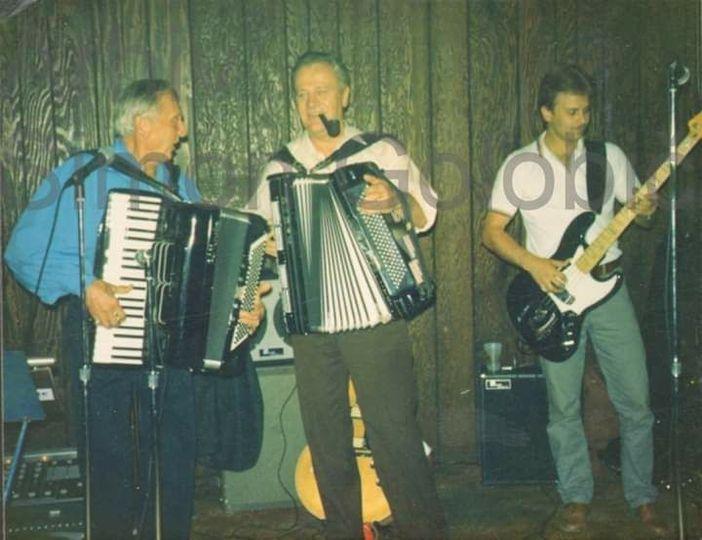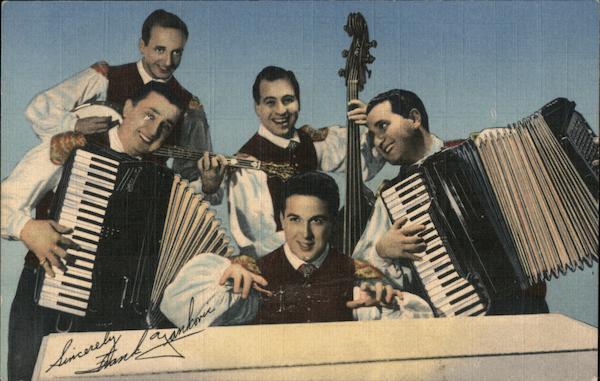If you’re new to Slovenian popular folk music (from Slovenia) or American-Slovenian style polkas (from North America), you might get confused between the two (I sure did), so in this post I try to clear it up with the sort of information I’d love to have had available several years ago.

Contents
Terminology
🇸🇮 Slovenian popular folk music (Narodnozabavna) (Oberkrainer)
- Slovene 🇸🇮: “Narodnozabavna” which translates to Slovenian popular folk music. Also referred to as “Domača glasba” and “Alpska glasba”.
- German 🇩🇪: typically referred to as “Oberkrainer” which is the German name for the Slovenian region of Gorenjska (English: Upper Carniola). Also referred to as “Volksmusik“.
- English 🇬🇧: “Slovenian popular folk music”, or “Slovenian alpine music”.
🇺🇸 American-Slovenian (Cleveland style)
- English 🇬🇧: “Cleveland style polka” or “American-Slovenian music”. It is also referred to in North America as “Slovenian style polka” which unfortunately doesn’t differentiate between American-Slovenian and Slovenian.
History
🇸🇮 Slovenian popular folk music (Narodnozabavna) (Oberkrainer)


- 1950’s: post World War Two Slovenia in 1953 when successful ski jumper turned musician Slavko Avsenik and his academic musician brother Vilko Ovsenik formed a trio, soon quartett, incorporating elements of Slovenian folk music with elements of popular music at the time (Jazz, Dixieland, Swing).
- ‘Avseniki’ (as they are affectionately known) soon evolved into a quintett with constantly evolving vocal formations. They became known as (Slovene) Ansambel bratov Avsenik or (German) Slavko Avsenik und seine Original Oberkrainer or (German) Original Oberkrainer. This marks the origin of the legendary ‘Oberkrainer’ quintett sound that is a trademark of Slovenian popular-folk music.
- The success of the Avsenik brothers was tremendous; over 30 million records sold over Europe, around 1000 original compositions, countless prestigious awards, thousands of concerts around Europe, tours in USA and Canada.
- 1960’s: button accordionist Lojze Slak formed another pioneering group, Ansambel Lojzeta Slaka with vocal group Fantje s Praprotna (Boys from Praprot). The trio (diatonic button accordion, double bass and guitar) was joined by a male vocal quartett, utilising similar rhythmic techniques of the Oberkrainer sound which was evolving since the 1950’s. This is an example of one of the earliest Slovenian Narodnozabavna trios with a male vocal group and a trio with a diatonic button accordion, which is also a trademark in Slovenian popular-folk music. By 1969, ‘Slaki’ had sold over 1 million records.
- Throughout his career, Lojze Slak had composed over 500 original songs, released over 40 albums and toured Europe, Australia, Canada and USA.
- Other huge successes followed throughout the 20th century, including Ansambel Franca Miheliča, Štajerskih 7, Štirje kovači, Ansambel Nagelj, Alpski Kvintet (Alpenoberkrainer), and so on. Likewise successful groups in Austria soon formed in the Oberkrainer style, including Heimatlandecho, Lechner Buam, Die Mooskirchner, Die Fidelen Mölltaler, Salzburg Quintett, and so on.
🇺🇸 American-Slovenian (Cleveland style)


- Button accordionist Matt (Matija) Hoyer (Hojer) migrated from Slovenia to USA and settled in Cleveland in 1911. Just as Avsenik and Slak are considered the grandfathers of Slovenian popular-folk music, Hoyer is referred to as the grandfather of American-Slovenian polka music.
- 1920’s: decades before the beginning of Avsenik and Slak’s careers took off in Slovenia, throughout the 1920s to 1940s Hoyer Trio had recorded several records with major American record labels such as Columbia and Victor.
- By the 1940s, Frankie Yankovic’s version of “Blue skirt waltz” sold over 2.5 million records and in the 1980s Yankovic had won a Grammy Award in the ‘polka’ category.
- Other successes in North America followed, such as Johnny Pecon, Frankie Yankovic (who sold over 30 million records throughout his career), Joey Miskulin, Walter Ostanek, and so on.
Where are they played?
🇸🇮 Slovenian popular folk music (Narodnozabavna) (Oberkrainer)
- Slovenia.
- German and Slovenian speaking alpine regions of Austria, Germany, Switzerland, North Italy (including Trieste), including German speaking areas of Netherlands.
- Northern Croatian region of Zagorje.
- Canada, USA, Australia (Slovenian and German speaking communities) as well as Oberkrainer enthusiasts in Japan.
🇺🇸 American-Slovenian (Cleveland style)
- USA (Slovenian and German speaking communities as well as Czech, Croatian, etc).
- To some extent in Canada (eg. Walter Ostanek).
Formations
🇸🇮 Slovenian popular folk music (Narodnozabavna) (Oberkrainer)
- Quintett with or without additional vocalists. Melody section: trumpet and clarinet alternating with accordion. Rhythm section: accordion (shaking rhythm), guitar, double bass or bass guitar alternating with baritone.
- Trio with or without additional vocalists. Melody section: accordion. Rhythm section: guitar, double bass or bass guitar alternating with baritone.
- Vocals: 1 or more voices, in Slovene or German. Duets and trios are most common (female, male or combination of both).
🇺🇸 American-Slovenian (Cleveland style)
- 3-6 piece groups with or without additional vocalists. Melody section: accordion, optional saxophone or optional clarinet. Rhythm section: optional banjo, double bass or bass guitar, drums, optional piano.
- Vocals: 1 or more voices, in Slovene, German, Croatian or English.
Most influential musicians and groups
🇸🇮 Slovenian popular folk music (Narodnozabavna) (Oberkrainer)
- Pioneering bands: Ansambel bratov Avsenik (Avseniki), Ansambel Lojzeta Slaka in Fantje s Praprotna (Slaki), Štirje kovači, Alpski Kvintet (Alpenoberkrainer), Ansambel Franca Miheliča (Ensemble Franz Mihelic), Fantje z vseh vetrov, Slovenski muzikantje (Oberkrainer Sextett), Ansambel Mihe Dovžana, Ansambel Borisa Franka, Henček In Njegovi Fantje, etc.
- Recent notable bands: Modrijani, Čuki, Ansambel Saša Avsenika, Okrogli Muzikantje, Ansambel Nazeva, Igor in Zlati Zvoki, Štajerskih 7, etc.
- Notable composers, lyricists and musicians: Tine Stare, Vera Šolinc, Ivan Sivec, Damir Tkavc, Denis Novato (Trieste), Robert Goter, Zoran Zorko, Jože Burnik, Boris Kovačič, etc.
- Notable vocalists: Danica Filiplič, Franc Koren, Alfi Nipič, Jožica Svete, Ema Prodnik, Joži Kališnik, Inge (Ingrid) Brüggemann, Franci Rebernik, Braco Koren, Elda Viler, Ivanka Kraševec Prešern, Oto Pesner, Stanka Kovačič, etc.
- Notable groups and musicians outside of Slovenia: Die Mooskirchner (Austria), Die Lungauer (Austria), Oberkrainer Power (Austria), Lechner Buam (Austria), Alexander Weisbecker (Austria), Sepp Neururer (Austria), Lechtaler Buam (Austria), Fantje s krasa (Trieste, Italy), Edelweisskapelle (Japan), Tokio Spitzbuam (Japan), Veseli Godci (USA), Gregorič Family (Canada), Murski Val (Canada), Alpine Sextett (USA), Ansambl Zagorje (Croatia).
🇺🇸 American-Slovenian (Cleveland style)
- Pioneering bands: Hoyer Trio, Frankie Yankovic, Johnny Pecon, Walter Ostanek, Eddie Habat, Richie Vadnal, Johnny Vadnal.
- Recent notable bands: Eddie Rodick Band, Klancnik and Friends, Steve Meisner Band, Mike Schneider Band, Don Wojtila Band, Anthony Culkar Band, Joshua Kay Band.
- Notable composers and musicians: Joey Miskulin, Alex Meixner, Lynn Marie, Ron Likovic, Joey Tomsick.
Popular songs
🇸🇮 Slovenian popular folk music (Narodnozabavna) (Oberkrainer)
- Na Golici (Ger: Trompetnecho) – Ansambel bratov Avsenik (Original Oberkrainer). This is the most popular hit in the genre and started Avseniki on their path to huge success in the German speaking market.
- Tam kjer murke cveto – Ansambel bratov Avsenik (Original Oberkrainer).
- V dolini tihi – Ansambel Lojzeta Slaka. Slovenians will instantly sing along to this.
- Sosedov Francelj – Ansambel Lojzeta Slaka
- Kam le čas beži – Stirje Kovaci
- Te domače viže – Fantje z vseh vetrov
- Čas počitnic (Ger: Schöne Urlaubszeit) – Alpski Kvintet (Alpenoberkrainer)
- Veseli Ribn’čan – Ansambel Franca Miheliča
- And so on…
🇺🇸 American-Slovenian (Cleveland style)
- Blue Skirt Waltz – Frankie Yankovic (adaptation of an old Czech song)
- In heaven there is no beer – Frankie Yankovic
- Zivili Brace, Zivili Sestra – Johnny Krizancic
- I wanna call you sweetheart – Joey Miskulin
- Let’s have a party – Walter Ostanek
- No Beer Today (V nedeljo piva ni) – The Vandals
- And so on…
Crossovers
- In 2021, Joey Miskulin released “Back to Slovenia” featuring his original compositions which were originally recorded in Cleveland-Style, but newly recorded with Slovenia’s top Oberkrainer musicians and vocalists, including Mike Orešar and Rudi Šantl.
- In 2006, Igor in Zlati Zvoki released a version of “Ta glažek je prazen” based on Richie Vandal’s Cleveland-Style arrangement.
- In 1971, The Vandals (Richie Vadnal Band) from Cleveland recorded and released an album in Slovenia for Slovenian record label Helidon (Vilko Ovsenik was involved in creating Helidon).
- In 1996 Alfi Nipič from Slovenia (Avsenik’s long serving male vocalist from the 1970s till 1990) performed for the Cleveland Style Polka Hall of Fame awards with American-Slovenian Oberkrainer style musicians including Duke (Dušan) Marsic.
- In the 1980s Ansambel Lojzeta Slaka performed their song ‘Ne prižigaj luči‘ in English as ‘Save the last dance’ in USA.
- Groups from Slovenia like Ansambel Henček and Boris Frank s svojimi kranjci had incorporated elements of Cleveland-style into their recordings
- In 1958, Johnny Pecon recorded “Little Fella” which became an instant hit, however it was unknowingly an adaptation Slavko & Vilko Avsenik’s “Tam kjer murke cveto”, without crediting the Avsenik brothers. Pecon later admitted that he had mistaken it for a folk song and was not aware who had composed it. Unfortunately this led to negative press in Slovenia, falsely accusing Slavko Avsenik of plagiarism. The Slovenian journalist was taken to court in order to clear Avsenik’s reputation. Interestingly in 1996 Slavko Avsenik won a lifetime achievement award at the Cleveland-Style Polka Hall of Fame Awards, during which Lou Trebar also performed “Little Fella” while Avsenik was in attendance.
Other great resources in English
🇸🇮 Slovenian popular folk music (Narodnozabavna) (Oberkrainer)
- slovenia.si – Slovenian popular folk music
- culture.si – Avsenik Ensemble
- clevelandstyle.com – Lojze Slak
🇺🇸 American-Slovenian (Cleveland style)
- polkas.nl – Comprehensive resources on Slovenian and Cleveland style music
- clevelandstyle.com – Cleveland-Style Polka Hall of Fame
- cleveland.com – Frankie Yankovic at 100: The life and times of one of Cleveland’s biggest stars
- soundfountain.org – Frankie Yankovic
- ipapolkas.com – Matt Hoyer
- Music from Both Sides – Gramophone Records Made by Matija Arko and the Hoyer Trio (by Drago Kunej, Rebeka Kunej 2017)
Hi Phillip,
My name is Mike (Miha) Dolinar from both the Alpine Sextet and the Veseli Godci. My role was as Guitarist, Lead singer, and Emcee. You may find it hard to believe, but almost all the members of those two bands mentioned above were the first born chidren of Slovenian parents who emigrated to the US after the Communist revolution. I’m curious as to where you got our names for your article as we did very little recording, choosing mostly to play mostly Festivals in the Midwest and Wedding receptions in the greater Cleveland area.
The picture you have of Yankovic playing with Avsenik was at a Gostilna called Frank Sterle’s Country House in Cleveland. The Alpine Sextet was playing an after concert celebration there after the Avsenik group played a concert at sold out the Ohio Theater. The fellow on the right playing Bass Is Paul Jurkovic. The Sextet was also invited to do a set with Avsenik.
Anyway, I play multiple string instruments and wanted to branch out to learn the button box. I’m trying to find a used one at a decent price. I’m not sure if you play piano or Frajtonerca harmonka. But i wanted to ask your advice on the Frece brand and get an idea on what a tytpical price range would be for a used button box.
Lep Pozdrav,
Miha Dolinar
Hi Miha, thanks for your comment, I’ll respond in more detail in an email.